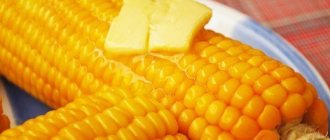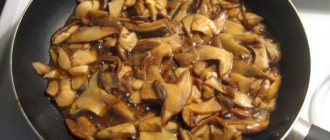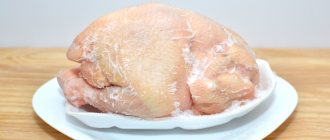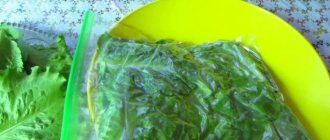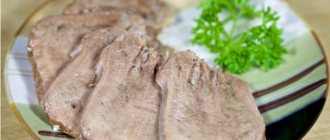How to cook squid correctly
A tasty and healthy delicacy, rich in protein, vitamins, minerals and microelements, was served back in Ancient Greece, calling this mollusk winged fish. Low calorie content (86 calories per 100 g), high nutritional value and the ability to have a beneficial effect on the body have turned squid into a popular dish for those who want to lose weight and get healthier. How to cook squid deliciously so that it decorates the holiday table? There are many ways and recipes for preparing this seafood, but they are all based on some general points that every housewife should know about. Many people are sure that cooking squid is very difficult, but this is an erroneous opinion, which you will have to debunk in practice.
How to choose the right squid
It is necessary to select these mollusks based on the appearance of the carcass.
Color of the skin
Skin color is almost never monochromatic. The shade can vary from grayish-pink to purple and even brown.
Squid meat
The meat should be light creamy.
If it is yellow or purple, this indicates that the squid has been defrosted and frozen several times during transportation and storage.
If the color of the meat is white, most likely the squid has been treated with some kind of chemicals.
The meat should be dense and elastic. There should not be a lot of ice and snow in the package.
Purified or not?
It is best to buy unpeeled squid. Then you can be sure that they have not been chemically treated.
If, nevertheless, the choice fell on a purified product, then it is worth taking those that were cut up and frozen directly on the ship. Such squids are cleaned mechanically and are not re-frozen. It is possible that this information can be read on the packaging.
How to quickly clean squid?
Unpeeled squid is considered to be of higher quality, since after factory cleaning the shellfish are cooked and become tough. Residents of the Mediterranean know how to properly clean squid, frozen or fresh: first defrost it at room temperature or in the refrigerator, then pour boiling water over it for one minute (during this time the skin will curl), drain the boiling water and place the squid in cold water. After this, you can easily remove the curled skin, remove the chord and entrails - and the squid can be cooked. This is the best way to ensure that the squid is soft, tender and juicy.
Product preparation
It is most convenient to work with already cut squids without heads and entrails, but it is not recommended to use skinned carcasses. On an industrial scale, chemical reagents are used to remove it. The skin color may be pinkish in juveniles or purple in older squids, but is never uniform. If the shellfish has already been thawed, its meat takes on a yellowish or gray tint, and the snow-white flesh of the carcass indicates chemical treatment. A good squid should have dense, light-colored meat and smell of the sea. The most delicious individuals are small, weighing up to 300 g, up to 15 cm long.
Defrosting
- Defrost the squid at room temperature, which will take 1-2 hours.
- The carcasses should be laid out on a plate in one layer.
- If you leave them on the bottom shelf of the refrigerator in the evening, they will thaw by morning.
- It is not advisable to immerse squid carcasses in cool water to thaw.
- If you don't have enough time, just pour them under the tap. The top layer of ice will disappear, the process will go faster.
You cannot use a microwave to defrost squid or throw carcasses into boiling water for the same purpose: they will harden.
Cutting
The best option is a carcass with skin, but without the head, entrails and tentacles. If you are dealing with a whole squid, then to cut it, grab the body with one hand, the head near the eyes with the other and pull in different directions. The head, along with the tentacles, is quite easily separated, and along with it the main part of the insides is removed. The tentacles can be cut off to cook separately.
- We cut the fleshy part of the carcass (in squid it is called the mantle) along the entire length.
- The thin film covering it, tripe and gladius, which replaces the mollusk's spine, are removed from the cavity. Gladius is a thin plate along the body that looks like transparent plastic.
- If you are going to stuff squid, there is no need to cut the mantle; perform all manipulations by touch.
- Before cooking, you need to remove the skin from the carcass.
- It will be much easier to clean the squid if you put them in a colander, scald them with boiling water, and then immediately transfer them to a pan of cold water.
- After this, it’s easy to remove the skin: pick it up with your nails and pull it off like a stocking.
- Remove any remaining residue from the meat with the blunt side of a knife.
Heat treatment
How to properly cook squid so that the meat is tender and soft? For 1 kg of product, pour 3 liters of water into a 5-liter saucepan and bring to a boil. If you don’t like the smell of fish that appears during cooking, you can add spices: black or allspice peas, bay leaf, dry dill seeds, cloves.
There is no need to put salt in the pan where the squid will be cooked: the meat will become too tough.
Boil peeled shellfish according to the following instructions:
- Place the squid carcass in boiling water. Small shellfish can be thrown in 2 at a time. There is no need to cut into pieces before doing this.
- Wait until the water boils again. Time it.
- Cook for 4-5 minutes.
- Place the carcasses in a colander or remove them from the water with a slotted spoon.
- Cool quickly. If it's hot, put it under a fan.
Overcooked squid becomes tough. You can soften it again by boiling it for 30-40 minutes, but this will lose many useful substances. However, you cannot reduce the heat treatment time even for a minute, because otherwise the bacteria and parasites that can be in any organism will not have time to die. For a squid carcass 15-20 cm long, 4 minutes of boiling is enough for this; if the meat is not completely defrosted, you need to add another 2 minutes. It is better not to buy individuals longer than 25 cm at all. The semi-finished product, cut into rings, is cooked for 2-3 minutes, if it is frozen - 1 minute longer.
Almost the same as in a saucepan, squid can be cooked in a slow cooker.
- Pour water, set to “Soup, boiling” mode.
- Wait for the signal and place the prepared carcasses into the bowl.
- Cook for 4 minutes, then cool immediately.
Shellfish are also steamed in a slow cooker, after which all the beneficial substances are retained in the meat. To do this you need:
- Pour water into a container and place the squid on the grill.
- Place a steam sieve and set the “Steaming” mode.
- After the water boils, cook for 10 minutes.
How to properly cook peeled and unpeeled squid
Add salt, peppercorns and bay leaves to the water, wait until the water boils, lower the squid carcass into it and take it out after 10 seconds. As soon as the water boils again, do the same with the second carcass, the third and all subsequent squids. To understand how to properly cook squid fillet, you just need to try this method, and then you will understand why all previous methods were unsuccessful. It turns out that long heat treatment (for 3-5 minutes) deprives squid of its taste and nutritional properties and turns it into rubber that is impossible to chew.
There is another way to properly cook frozen squid (it should, of course, be defrosted first) - you need to boil water with salt and spices, put the shellfish in there and immediately remove from the heat. You need to infuse this delicacy for 10 minutes.
And now we will tell you how to properly boil frozen squid without defrosting: you just need to put them in boiling water for one minute, turn off the heat, and then keep them in the water for another 3-4 minutes.
How to cook squid in kitchen gadgets
Modern housewives often use kitchen gadgets to cook seafood for salad. Cooking time depends on the choice of assistant.
- In a double boiler - 5 minutes.
- Multicooker - 2 minutes.
- Microwave – 1 minute on maximum mode.
- Pressure cooker - a minute.
Rules for sampling squid
If you don’t want to spoil your dish with a stale product, learn how to choose seafood.
When properly frozen and stored, the external appearance of the carcass is pinkish, with a brown or purple tint. The pulp is dense, white on the inside.
I advise you to buy frozen and unpeeled shellfish, they are more beneficial. If there is a lot of ice or liquid in the package, or frozen carcasses, do not take them, as you risk running into a product that has been repeatedly frozen.
How to properly fry squid
Before frying, squid should be boiled using one of the above methods, cut into rings or strips, dipped in lezon (beaten eggs with sour cream, salt and spices), rolled in breadcrumbs and fried in vegetable or butter for no more than five minutes.
Some novice cooks are interested in how to properly cook squid fried in batter. This very simple dish is made in exactly the same way - boiled and chopped shellfish are lightly marinated, dipped in batter and fried in a lot of oil.
Very tasty squids are obtained in the oven or on the grill, but they must first be marinated for several hours in lemon juice with garlic, pepper and paprika. Then the squid should be placed on a wire rack and baked, pouring over the remaining marinade.
Cook in the microwave
Dishes in which squid is one of the ingredients are always exquisite and tasty. It is impossible not to prepare them for the holiday table. In addition, they are cooked quite simply, and in addition to most of their positive qualities, they are distinguished by their high protein content and low calorie content. You can cook squid for a huge number of dishes, from soups to salads, pies and much more. Every gourmet can easily find a video in which he can quickly boil squid for a dish.
If you don’t have any free time to cook, look at how long it takes to cook squid in the microwave and try one of your favorite recipes.
How to properly stuff squid
First, the squids are washed, doused with boiling water, then each carcass is cleaned and lightly beaten. Next, you need to fill the carcass two-thirds with stuffing, which includes mushrooms with eggs, vegetables with rice, shrimp with cheese, green beans and onions, apples and cottage cheese. The edges of the carcasses are fastened with skewers, after which the squids are stewed in the oven with a small amount of water, and five minutes before they are ready, they are sprinkled with cheese and put back in the oven until golden brown. The finished dish is topped with nut, tomato, cream, sour cream, wine, soy or onion sauce.
In many squid recipes you can find unexpected combinations - squid with minced meat, with bread and sprat, with crab sticks and corn, with nuts and dried fruits.
Each national cuisine has its own secrets for preparing squid, but there is one main rule. You should not overload squid with spices and herbs, as they intensively absorb the aroma of surrounding products, and the dish may turn out to be too rich. How to properly cook squid is just the beginning. It is important to choose a suitable side dish (rice, vegetables, pasta) and serve the dish correctly, garnishing it with fresh vegetables, lemon, herbs and olives. In Southeast Asia, squids are eaten raw, sprinkled with spicy sauces, but such extreme food is not for those who like to cook and enjoy delicious food!
How to properly clean squid
The first question that arises most often is how and when to clean squid carcasses, before or after cooking. Is it possible to peel them already boiled, and in general - why remove the film?
As a rule, seafood products are sold frozen and unpeeled. And this is a big plus, since there is a guarantee that the squid was frozen immediately after catching, right on the ship or at a processing plant located on the seashore. On sale there are shellfish that are ready for cooking - peeled. In this case, there is a high probability that the product has been thawed at least once. Therefore, unpeeled carcasses are considered to be of higher quality and healthier.
Why remove film from squid?
During the cooking process, due to exposure to high temperatures, the film becomes especially hard, which will affect the quality of the dish. In addition, a salad with unpeeled squid looks sloppy and unappetizing.
Squid selection and preparation
The key to successful preparation of squid is the choice of a quality product. When purchasing, you need to pay close attention to the color of the meat. In good fresh squid it is whitish, even completely white. Yellowness will indicate that the carcass has been stored for too long, even in the refrigerator.
When buying ice-glazed squid, you need to inspect it. If there is an ice crust on the surface, then most likely the glaze layer is too thick and after defrosting it will turn out that not so much meat was purchased. This also happens if squid carcasses were thawed and then frozen again. In this case, you cannot eat them at all.
After cooking, the meat of small squid will be the juiciest and most tender - this is what you should look for in the store in the first place.
It is best to buy squid without tentacles and heads. Then, after defrosting, you just need to remove the film from them. If you still bought whole carcasses, you will have to cut them yourself. It is not difficult. You need to take the squid's head, grasping the eye area with your fingers, and then pull the rest of the part, holding it with the other hand. This way you will clean the carcass from the insides. Then you need to remove the chitinous film. It can be felt with your hand without any problems, so there are no special problems with freeing the squid carcass from it.
The worst thing is to remove the outer reddish-white film. To make this step easier, you can use a trick: pour hot, but by no means boiling, water over the squid, and after a minute remove it from the water and rinse it under the tap. After this, the film is easily picked up with a knife and thus removed from the carcass.
Cleaned squid meat can be prepared in different ways.
Cooking recipes
Cooking squid in the microwave, double boiler and slow cooker.
When using a double boiler, we will cook seafood without water. To do this, place pre-cleaned and washed rings or carcasses of marine life in the steamer bowl. Cook them for about ten minutes. The shellfish are tender and tasty. The only drawback of this method is the lack of broth from which you can make soup or sauce.
You can similarly prepare this product in a slow cooker. In this case, you need to use the “steam cooking” function.
Seafood can be cooked deliciously in the microwave . To do this, take a special dish with a lid and place the prepared shellfish in it. Add a little lemon juice, close the lid tightly and cook in the microwave for about two minutes. You can also add marinade to the squid, which will make it more aromatic and spicy.
Tips and tricks
- If necessary, squids can be left uncooked. Just put them in a deep bowl, sprinkle with salt, spices and pour boiling water over them. We wait four minutes - and the tender meat is ready.
- If the cooking time is short, add vinegar to the water. It will not only improve the taste of seafood, but will also kill all germs.
- When boiling shellfish, add lemon, orange or grapefruit zest to the water. This will give the seafood a unique aroma and taste.
- Squids can not only be boiled, but also fried. Place them on a hot frying pan and fry for a couple of minutes. Squids prepared in this way will have an appetizing and crispy crust.
Squid is a healthy and necessary product for the body. Knowing all the intricacies of boiling it, you can easily make a delicious dish from these sea creatures.
Cooking squid in a double boiler
Perhaps the most tender squid is obtained in a double boiler.
For 2-3 small squid carcasses you need to take 3 bay leaves and 3 peppercorns. Place the cleaned squids in a steamer. Pour water into a suitable container and place the pepper and bay leaf there. Set the timer for 9 minutes. Do not open the steamer during cooking7
By the way, if you don’t have a double boiler, then it’s quite possible to create one from a saucepan, gauze and a colander. Thus, you will need to cook the squid for 6 minutes rather than 9. Remove the finished meat, add salt and serve.
Types of squid
There are 10 species of squid that are edible, but 2–3 varieties are found in fish stores:
- Commander squid is found in the Seas of Japan and Okhotsk, and is caught by Russian fishermen.
- Patagonian squid, which lives near the Falkland Islands, is supplied frozen to stores in Spain.
- Common squid, found in the Adriatic and Mediterranean seas. This is what is most often sold fresh.
- The giant squid is used for cutting into rings and fillets, and it lives in the Atlantic Ocean.
The market offers customers a wide range of squid:
- smoked and fresh frozen;
- breaded or in oil;
- dried or salted.
Useful tips
The first thing to remember is that squid carcasses cannot be re-frozen, so you must initially correctly calculate how much seafood needs to be defrosted for the dish. In general, almost all seafood spoils when re-frozen and loses its individual taste. Please note that while in the freezer, seafood changes its structure, causing the carcasses to become harder and tougher. Therefore, use shellfish as quickly as possible.
Marinade is another way to store squid. But this method is shorter-term and allows you to leave pre-cleaned foods in the refrigerator for about 2 days. Skilled smokehouse owners can also use the smoking method for long-term storage. These simple rules will help prevent spoilage of squid and keep them in the proper form for cooking.
You need to remove the squid from the packaging immediately before cooking it, this way the juiciness and structure of the carcass will be preserved. By the way, it is also better to store seafood in its original packaging, if it is not printed. But there is no need to leave squid in plastic films or bags. It's better to wrap them in parchment paper.
Dishes with squid
Tomato soup with squid
Prepared like a classic seafood soup. Chop the shallots, garlic, thyme, fry everything in a frying pan in oil. Add cleaned squid, then a quarter glass of white wine, evaporate, pour vegetable or fish broth over everything. Peel the tomatoes, chop to a puree consistency and add to the total mass. Let it boil, cook for 2 minutes, add butter, salt, pepper, sugar.
Ingredients for tomato soup with squid
Tomato soup with squid
Breaded squid rings
Cut the cleaned squid into rings, add salt and pepper. Separately prepare the standard ingredients for breading: egg, flour, crackers. Dip the squid in flour, then in a well-beaten egg, again in flour and carefully coat in breadcrumbs.
Place the breaded rings in the freezer for 10 minutes - this will “set the shape” and make them easier to fry. Heat the oil to 160 degrees, lower the squid rings into the oil for 1.5 minutes. Place on a napkin to drain excess oil. Serve with any sauces: tartar, adjika, garlic, sour cream or hot sauce.
Ingredients for breaded malmars
Breaded squid rings
Stuffed squid
Pre-clean the squid. Wrap the potatoes in foil and bake in the oven, then cut out the core, mix with butter and soft cheese, add finely chopped poached green onions. Stuff the cleaned squid with the filling, pierce it with a skewer, and fry in a frying pan for 40 seconds until golden brown. Place on parchment and place in the oven for 5 minutes at 180 degrees. Serve the appetizer with green butter and cherry tomatoes.
Ingredients for stuffed squid
Stuffed squid
Product processing
Not many housewives know how to cook squid correctly, so they often spoil their taste.
Cooking process
If you are using fresh squid , then all you need to do is wash it thoroughly and remove the skin. Things are more complicated with the preparation of frozen sea creatures. Before cooking, they need to be properly defrosted, since their taste will directly depend on this. There is no need to pour hot water over frozen clams to speed up the process. This destroys all the beneficial properties of the product and also significantly impairs the taste.
To properly defrost squids, they need to be placed in the refrigerator, where they will gradually thaw. After a few hours (without allowing complete thawing), remove them from the refrigerator. Such shellfish are easy to process, while they retain all their nutritional properties.
